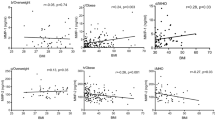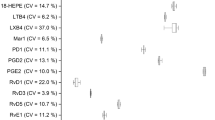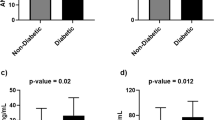Abstract
Background and objectives:
Matrix metalloproteinases (MMPs) are involved in several inflammatory processes including obesity-related vascular diseases and graft failure of coronary artery (CA) bypass grafts [internal mammary artery (IMA), saphenous vein (SV)]. In these inflammatory conditions, the release of prostaglandin E2 (PGE2) is increased via the activity of inducible microsomal PGE synthase-1 (mPGES-1). Our aim was to investigate whether MMPs and their endogenous inhibitor (TIMPs) may be regulated by PGE2 under inflammatory conditions in human vasculature and perivascular adipose tissue (PVAT), as well as in plasma of obese patients.
Methods:
MMP-1,-2 and TIMP-1,-2 densities were measured in human plasma (n = 68) as well as in supernatants of human vascular wall (IMA n = 16, SV n = 14, CA n = 13) and their PVAT. The effects of inflammation and mPGES-1 inhibitor (Compound III, 10 µM) on MMPs regulation were evaluated. The correlations between PGE2 and several parameters were calculated in plasma from patients with or without obesity.
Results:
The vascular wall and PVAT from SV exhibited the greatest MMP-1,-2 release. An increase of MMP-1,-2 and/or a decrease of TIMP-1 quantities have been detected under inflammation only in vascular wall not in PVAT. These changes under inflammation were completely reversed by inhibition of mPGES-1. In obesity, C-reactive protein (CRP), biomarker of inflammation, and PGE2 levels were increased. PGE2 contents were positively correlated with some anthropometric parameters and plasmatic CRP in both genders, while the correlation with the plasmatic MMP-1 density was significant only in women.
Conclusions:
The greater MMP activity observed in SV may contribute to the increased prevalence of graft failure. Under inflammation, the greater mPGES-1 and PGE2 levels lead to enhanced MMP activity in human vascular walls. The positive association between PGE2 and MMP-1 or CRP has been observed in plasma of women. We suggest that mPGES-1 inhibitors could prevent graft failure and obesity-related vascular remodeling mostly in women.
This is a preview of subscription content, access via your institution
Access options
Subscribe to this journal
Receive 12 print issues and online access
$259.00 per year
only $21.58 per issue
Buy this article
- Purchase on Springer Link
- Instant access to full article PDF
Prices may be subject to local taxes which are calculated during checkout




Similar content being viewed by others
References
Gomez I, Foudi N, Longrois D, Norel X. The role of prostaglandin E2 in human vascular inflammation. Prostaglandins Leukot Essent Fatty Acids. 2013;89:55–63.
Bishop-Bailey D, Pepper JR, Haddad EB, Newton R, Larkin SW, Mitchell JA. Induction of cyclooxygenase-2 in human saphenous vein and internal mammary artery. Arterioscler Thromb Vasc Biol. 1997;17:1644–8.
Bishop-Bailey D, Pepper JR, Larkin SW, Mitchell JA. Differential induction of cyclooxygenase-2 in human arterial and venous smooth muscle: role of endogenous prostanoids. Arterioscler Thromb Vasc Biol. 1998;18:1655–61.
Camacho M, Gerboles E, Escudero JR, Anton R, Garcia-Moll X, Vila L. Microsomal prostaglandin E synthase-1, which is not coupled to a particular cyclooxygenase isoenzyme, is essential for prostaglandin E(2) biosynthesis in vascular smooth muscle cells. J Thromb Haemost. 2007;5:1411–9.
Camacho M, Rodriguez C, Guadall A, Alcolea S, Orriols M, Escudero JR, et al. Hypoxia upregulates PGI-synthase and increases PGI(2) release in human vascular cells exposed to inflammatory stimuli. J Lipid Res. 2011;52:720–31.
Gomez I, Benyahia C, Louedec L, Leseche G, Jacob MP, Longrois D, et al. Decreased PGE(2) content reduces MMP-1 activity and consequently increases collagen density in human varicose vein. PLoS ONE. 2014;9:e88021.
Gomez I, Ozen G, Deschildre C, Amgoud Y, Boubaya L, Gorenne I, et al. Reverse regulatory pathway (H2S / PGE2 / MMP) in human aortic aneurysm and saphenous vein varicosity. PLoS ONE. 2016;11:e0158421.
Yokoyama U, Ishiwata R, Jin MH, Kato Y, Suzuki O, Jin H, et al. Inhibition of EP4 signaling attenuates aortic aneurysm formation. PLoS ONE. 2012;7:e36724.
Galis ZS, Muszynski M, Sukhova GK, Simon-Morrissey E, Unemori EN, Lark MW, et al. Cytokine-stimulated human vascular smooth muscle cells synthesize a complement of enzymes required for extracellular matrix digestion. Circ Res. 1994;75:181–9.
Montero I, Orbe J, Varo N, Beloqui O, Monreal JI, Rodriguez JA, et al. C-reactive protein induces matrix metalloproteinase-1 and -10 in human endothelial cells: implications for clinical and subclinical atherosclerosis. J Am Coll Cardiol. 2006;47:1369–78.
Qin W, Lu W, Li H, Yuan X, Li B, Zhang Q, et al. Melatonin inhibits IL1beta-induced MMP9 expression and activity in human umbilical vein endothelial cells by suppressing NF-kappaB activation. J Endocrinol. 2012;214:145–53.
Galis ZS, Muszynski M, Sukhova GK, Simon-Morrissey E, Libby P. Enhanced expression of vascular matrix metalloproteinases induced in vitro by cytokines and in regions of human atherosclerotic lesions. Ann N Y Acad Sci. 1995;748:501–7.
Reuben PM, Cheung HS. Regulation of matrix metalloproteinase (MMP) gene expression by protein kinases. Front Biosci. 2006;11:1199–215.
Anstadt MP, Franga DL, Portik-Dobos V, Pennathur A, Bannan M, Mawulawde K, et al. Native matrix metalloproteinase characteristics may influence early stenosis of venous versus arterial coronary artery bypass grafting conduits. Chest. 2004;125:1853–8.
Ozen G, Topal G, Gomez I, Ghorreshi A, Boukais K, Benyahia C, et al. Control of human vascular tone by prostanoids derived from perivascular adipose tissue. Prostaglandins Other Lipid Mediat. 2013;107:13–7.
Turner NA, Ho S, Warburton P, O’Regan DJ, Porter KE. Smooth muscle cells cultured from human saphenous vein exhibit increased proliferation, invasion, and mitogen-activated protein kinase activation in vitro compared with paired internal mammary artery cells. J Vasc Surg. 2007;45:1022–8.
Ozen G, Gomez I, Daci A, Deschildre C, Boubaya L, Teskin O, et al. Inhibition of microsomal PGE synthase-1 reduces human vascular tone by increasing PGI2: a safer alternative to COX-2 inhibition. Br J Pharmacol. 2017;174:4087–98.
Sun Y, Kang L, Li J, Liu H, Wang Y, Wang C, et al. Advanced glycation end products impair the functions of saphenous vein but not thoracic artery smooth muscle cells through RAGE/MAPK signalling pathway in diabetes. J Cell Mol Med. 2016;20:1945–55.
Ozen G, Daci A, Norel X, Topal G. Human perivascular adipose tissue dysfunction as a cause of vascular disease: focus on vascular tone and wall remodeling. Eur J Pharmacol. 2015;766:16–24.
Yun CH, Lin TY, Wu YJ, Liu CC, Kuo JY, Yeh HI, et al. Pericardial and thoracic peri-aortic adipose tissues contribute to systemic inflammation and calcified coronary atherosclerosis independent of body fat composition, anthropometric measures and traditional cardiovascular risks. Eur J Radiol. 2012;81:749–56.
Taylor LE, Sullivan JC. Sex differences in obesity-induced hypertension and vascular dysfunction: a protective role for estrogen in adipose tissue inflammation? Am J Physiol Regul Integr Comp Physiol. 2016;311:R714–20.
Xia N, Li H. The role of perivascular adipose tissue in obesity-induced vascular dysfunction. Br J Pharmacol. 2017;174:3425–42.
Rocha VZ, Libby P. Obesity, inflammation, and atherosclerosis. Nat Rev Cardiol. 2009;6:399–409.
Aghamohammadzadeh R, Greenstein AS, Yadav R, Jeziorska M, Hama S, Soltani F, et al. Effects of bariatric surgery on human small artery function: evidence for reduction in perivascular adipocyte inflammation, and the restoration of normal anticontractile activity despite persistent obesity. J Am Coll Cardiol. 2013;62:128–35.
Ketonen J, Shi J, Martonen E, Mervaala E. Periadventitial adipose tissue promotes endothelial dysfunction via oxidative stress in diet-induced obese C57Bl/6 mice. Circ J. 2010;74:1479–87.
Marchesi C, Ebrahimian T, Angulo O, Paradis P, Schiffrin EL. Endothelial nitric oxide synthase uncoupling and perivascular adipose oxidative stress and inflammation contribute to vascular dysfunction in a rodent model of metabolic syndrome. Hypertension. 2009;54:1384–92.
Bruins P, te Velthuis H, Yazdanbakhsh AP, Jansen PG, van Hardevelt FW, de Beaumont EM, et al. Activation of the complement system during and after cardiopulmonary bypass surgery: postsurgery activation involves C-reactive protein and is associated with postoperative arrhythmia. Circulation. 1997;96:3542–8.
Faymonville ME, Deby-Dupont G, Larbuisson R, Deby C, Bodson L, Limet R, et al. Prostaglandin E2, prostacyclin, and thromboxane changes during nonpulsatile cardiopulmonary bypass in humans. J Thorac Cardiovasc Surg. 1986;91:858–66.
Joffs C, Gunasinghe HR, Multani MM, Dorman BH, Kratz JM, Crumbley AJ 3rd, et al. Cardiopulmonary bypass induces the synthesis and release of matrix metalloproteinases. Ann Thorac Surg. 2001;71:1518–23.
Sesso HD, Wang L, Buring JE, Ridker PM, Gaziano JM. Comparison of interleukin-6 and C-reactive protein for the risk of developing hypertension in women. Hypertension. 2007;49:304–10.
Ogihara T, Gotoh S, Tabuchi Y, Kumahara Y. Involvement of endogenous prostaglandins in salt-induced hypertension. Acta Endocrinol (Copenh). 1985;108:114–8.
Yasmin, McEniery CM, Wallace S, Dakham Z, Pulsalkar P, Maki-Petaja K, et al. Matrix metalloproteinase-9 (MMP-9), MMP-2, and serum elastase activity are associated with systolic hypertension and arterial stiffness. Arterioscler Thromb Vasc Biol. 2005;25:372.
Derosa G, Maffioli P, D’Angelo A, Salvadeo SA, Ferrari I, Fogari E, et al. Evaluation of metalloproteinase 2 and 9 levels and their inhibitors in combined dyslipidemia. Clin Invest Med. 2009;32:E124–32.
Virdis A, Duranti E, Rossi C, Dell’Agnello U, Santini E, Anselmino M, et al. Tumour necrosis factor-alpha participates on the endothelin-1/nitric oxide imbalance in small arteries from obese patients: role of perivascular adipose tissue. Eur Heart J. 2015;36:784–94.
British Pharmacological Society. Contractions of human coronary vessels induced by prostaglandin E2 are mediated via EP3 receptor and modulated by perivascular adipose tissue. Pharmacology. 2015. http://www.pa2online.org/abstract/abstract.jsp?abid=32972&author=Ozen&cat=-1&period=-1.
Gomez I, Benyahia C, Le Dall J, Payre C, Louedec L, Leseche G, et al. Absence of inflammatory conditions in human varicose saphenous veins. Inflamm Res. 2013;62:299–308.
Jabs WJ, Theissing E, Nitschke M, Bechtel JF, Duchrow M, Mohamed S, et al. Local generation of C-reactive protein in diseased coronary artery venous bypass grafts and normal vascular tissue. Circulation. 2003;108:1428–31.
Foudi N, Louedec L, Cachina T, Brink C, Norel X. Selective cyclooxygenase-2 inhibition directly increases human vascular reactivity to norepinephrine during acute inflammation. Cardiovasc Res. 2009;81:269–77.
Leclerc P, Idborg H, Spahiu L, Larsson C, Nekhotiaeva N, Wannberg J, et al. Characterization of a human and murine mPGES-1 inhibitor and comparison to mPGES-1 genetic deletion in mouse models of inflammation. Prostaglandins Other Lipid Mediat. 2013;107:26–34.
Kim FY, Marhefka G, Ruggiero NJ, Adams S, Whellan DJ. Saphenous vein graft disease: review of pathophysiology, prevention, and treatment. Cardiol Rev. 2013;21:101–9.
Sur S, Sugimoto JT, Agrawal DK. Coronary artery bypass graft: why is the saphenous vein prone to intimal hyperplasia? Can J Physiol Pharmacol. 2014;92:531–45.
Sukhova GK, Schonbeck U, Rabkin E, Schoen FJ, Poole AR, Billinghurst RC, et al. Evidence for increased collagenolysis by interstitial collagenases-1 and -3 in vulnerable human atheromatous plaques. Circulation. 1999;99:2503–9.
Moore CS, Crocker SJ. An alternate perspective on the roles of TIMPs and MMPs in pathology. Am J Pathol. 2012;180:12–6.
Dashwood MR, Tsui JC. ‘No-touch’ saphenous vein harvesting improves graft performance in patients undergoing coronary artery bypass surgery: a journey from bedside to bench. Vasc Pharmacol. 2013;58:240–50.
Costa RM, Neves KB, Tostes RC, Lobato NS. Perivascular adipose tissue as a relevant fat depot for cardiovascular risk in obesity. Front Physiol. 2018;9:253.
Paz MA, Lupon J, Bosch X, Pomar JL, Sanz G. Predictors of early saphenous vein aortocoronary bypass graft occlusion. The GESIC Study Group. Ann Thorac Surg. 1993;56:1101–6.
Samuvel DJ, Jin J, Sundararaj KP, Li Y, Zhang X, Lopes-Virella MF, et al. TLR4 activation and IL-6-mediated cross talk between adipocytes and mononuclear cells synergistically stimulate MMP-1 expression. Endocrinology. 2011;152:4662–71.
DeVallance E, Branyan KW, Lemaster K, Olfert IM, Smith DM, Pistilli EE et al. Aortic dysfunction in metabolic syndrome mediated by perivascular adipose tissue TNFalpha and NOX2 dependent pathway. Exp Physiol. 2018;103:590–603.
Moe KT, Naylynn TM, Yin NO, Khairunnisa K, Allen JC, Wong MC, et al. Tumor necrosis factor-alpha induces aortic intima-media thickening via perivascular adipose tissue inflammation. J Vasc Res. 2013;50:228–37.
Pearson TA, Mensah GA, Alexander RW, Anderson JL, Cannon RO 3rd, Criqui M, et al. Markers of inflammation and cardiovascular disease: application to clinical and public health practice: a statement for healthcare professionals from the Centers for Disease Control and Prevention and the American Heart Association. Circulation. 2003;107:499–511.
Garcia-Alonso V, Titos E, Alcaraz-Quiles J, Rius B, Lopategi A, Lopez-Vicario C, et al. Prostaglandin E2 exerts multiple regulatory actions on human obese adipose tissue remodeling, inflammation, adaptive thermogenesis and lipolysis. PLoS ONE. 2016;11:e0153751.
Cunha NV, de Abreu SB, Panis C, Grassiolli S, Guarnier FA, Cecchini R, et al. Cox-2 inhibition attenuates cardiovascular and inflammatory aspects in monosodium glutamate-induced obese rats. Life Sci. 2010;87:375–81.
Pham Huu C, Palhares de Miranda AL, Navarro-Delmasure C, Pham Huu Chanh A, Moutier R. Comparative study of the biosynthesis of PGE2, PGF2 alpha and TXA2 by different organs of genetically hypertensive (SHR) and obese-hypertensive (SHR-fa/fa) rats. Prostaglandins Leukot Med. 1987;26:21–32.
Rocha-Rodrigues S, Rodriguez A, Goncalves IO, Moreira A, Maciel E, Santos S, et al. Impact of physical exercise on visceral adipose tissue fatty acid profile and inflammation in response to a high-fat diet regimen. Int J Biochem Cell Biol. 2017;87:114–24.
Wu D, Ren Z, Pae M, Han SN, Meydani SN. Diet-induced obesity has a differential effect on adipose tissue and macrophage inflammatory responses of young and old mice. Biofactors. 2013;39:326–33.
Luizon MR, Belo VA, Fernandes KS, Andrade VL, Tanus-Santos JE, Sandrim VC. Plasma matrix metalloproteinase-9 levels, MMP-9 gene haplotypes, and cardiovascular risk in obese subjects. Mol Biol Rep. 2016;43:463–71.
Gomez-Hernandez A, Sanchez-Galan E, Ortego M, Martin-Ventura JL, Blanco-Colio LM, Tarin-Vicente N, et al. Effect of intensive atorvastatin therapy on prostaglandin E2 levels and metalloproteinase-9 activity in the plasma of patients with non-ST-elevation acute coronary syndrome. Am J Cardiol. 2008;102:12–8.
Cho BS, Roelofs KJ, Ford JW, Henke PK, Upchurch GR Jr. Decreased collagen and increased matrix metalloproteinase-13 in experimental abdominal aortic aneurysms in males compared with females. Surgery. 2010;147:258–67.
Sokolis DP, Iliopoulos DC. Impaired mechanics and matrix metalloproteinases/inhibitors expression in female ascending thoracic aortic aneurysms. J Mech Behav Biomed Mater. 2014;34:154–64.
Melekoglu R, Ciftci O, Eraslan S, Basak N, Celik E. The effects of body mass index on second-trimester amniotic fluid cytokine and matrix metalloproteinase levels. Gynecol Obstet Invest. 2018;83:70–5.
Papazoglou D, Papatheodorou K, Papanas N, Papadopoulos T, Gioka T, Kabouromiti G, et al. Matrix metalloproteinase-1 and tissue inhibitor of metalloproteinases-1 levels in severely obese patients: what is the effect of weight loss? Exp Clin Endocrinol Diabetes. 2010;118:730–4.
Andrade VL, Petruceli E, Belo VA, Andrade-Fernandes CM, Caetano Russi CV, Bosco AA, et al. Evaluation of plasmatic MMP-8, MMP-9, TIMP-1 and MPO levels in obese and lean women. Clin Biochem. 2012;45:412–5.
Heine PA, Taylor JA, Iwamoto GA, Lubahn DB, Cooke PS. Increased adipose tissue in male and female estrogen receptor-alpha knockout mice. Proc Natl Acad Sci USA. 2000;97:12729–34.
Pedersen SB, Kristensen K, Hermann PA, Katzenellenbogen JA, Richelsen B. Estrogen controls lipolysis by up-regulating alpha2A-adrenergic receptors directly in human adipose tissue through the estrogen receptor alpha. Implications for the female fat distribution. J Clin Endocrinol Metab. 2004;89:1869–78.
Gallicchio L, Visvanathan K, Miller SR, Babus J, Lewis LM, Zacur H, et al. Body mass, estrogen levels, and hot flashes in midlife women. Am J Obstet Gynecol. 2005;193:1353–60.
Nilsson M, Dahlman I, Ryden M, Nordstrom EA, Gustafsson JA, Arner P, et al. Oestrogen receptor alpha gene expression levels are reduced in obese compared to normal weight females. Int J Obes (Lond). 2007;31:900–7.
Claassen H, Steffen R, Hassenpflug J, Varoga D, Wruck CJ, Brandenburg LO, et al. 17beta-estradiol reduces expression of MMP-1, -3, and -13 in human primary articular chondrocytes from female patients cultured in a three dimensional alginate system. Cell Tissue Res. 2010;342:283–93.
Singer CF, Marbaix E, Kokorine I, Lemoine P, Donnez J, Eeckhout Y, et al. Paracrine stimulation of interstitial collagenase (MMP-1) in the human endometrium by interleukin 1alpha and its dual block by ovarian steroids. Proc Natl Acad Sci USA. 1997;94:10341–5.
Humphries KH, Gao M, Pu A, Lichtenstein S, Thompson CR. Significant improvement in short-term mortality in women undergoing coronary artery bypass surgery (1991 to 2004). J Am Coll Cardiol. 2007;49:1552–8.
Hassan A, Chiasson M, Buth K, Hirsch G. Women have worse long-term outcomes after coronary artery bypass grafting than men. Can J Cardiol. 2005;21:757–62.
Woods SE, Noble G, Smith JM, Hasselfeld K. The influence of gender in patients undergoing coronary artery bypass graft surgery: an eight-year prospective hospitalized cohort study. J Am Coll Surg. 2003;196:428–34.
Vaccarino V, Abramson JL, Veledar E, Weintraub WS. Sex differences in hospital mortality after coronary artery bypass surgery: evidence for a higher mortality in younger women. Circulation. 2002;105:1176–81.
Korotkova M, Daha NA, Seddighzadeh M, Ding B, Catrina AI, Lindblad S, et al. Variants of gene for microsomal prostaglandin E2 synthase show association with disease and severe inflammation in rheumatoid arthritis. Eur J Hum Genet. 2011;19:908–14.
Acknowledgements
This work was supported by Scientific Research Project Coordination Unit of Istanbul University (Project number: BEK-2017-27545 and 44747) and INSERM (Institut National de la Santé et de la Recherche Médicale). GO is a recipient of a postgraduate fellowship (BIDEB-2214) from the Scientific and Technological Research Council of Turkey (TUBITAK). We thank the Department of Cardiac Surgery at Bichat Hospital Paris, France, for providing vascular preparations and the Biobank of INSERM U1148 for CA samples.
Author information
Authors and Affiliations
Corresponding author
Ethics declarations
Conflict of interest
PJJ is a member of the board of Gensynta Pharma AB. All other authors declare that they have no conflicts of interest.
Electronic supplementary material
Rights and permissions
About this article
Cite this article
Ozen, G., Boumiza, S., Deschildre, C. et al. Inflammation increases MMP levels via PGE2 in human vascular wall and plasma of obese women. Int J Obes 43, 1724–1734 (2019). https://doi.org/10.1038/s41366-018-0235-6
Received:
Revised:
Accepted:
Published:
Issue Date:
DOI: https://doi.org/10.1038/s41366-018-0235-6
This article is cited by
-
MMPs and TIMPs levels are correlated with anthropometric parameters, blood pressure, and endothelial function in obesity
Scientific Reports (2021)
-
Prostaglandin Endoperoxide H Synthase-2 (PGHS-2) Variants and Risk of Obesity and Microvascular Dysfunction Among Tunisians: Relevance of rs5277 (306G/C) and rs5275 (8473T/C) Genetic Markers
Biochemical Genetics (2021)
-
Medications for Chronic Conditions and Periodontal Disease
Current Oral Health Reports (2019)



